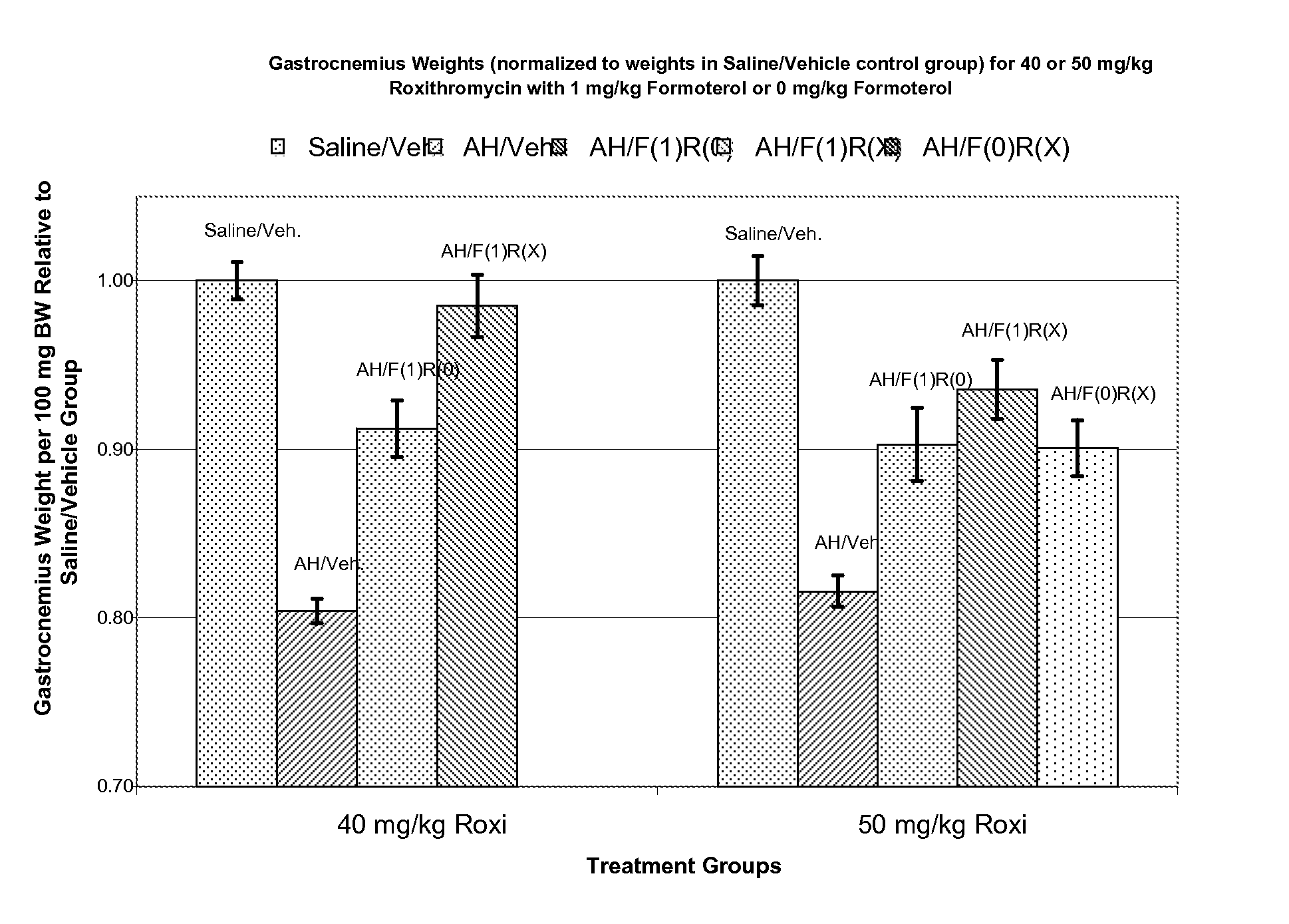Compositions and methods for prevention and treatment of cachexia
a technology applied in the field of compositions and methods for preventing and treating metabolic disorders, can solve the problems of reducing the tolerance of medications, reducing the functional ability and quality of life of patients, and worsening the underlying condition, so as to improve health, prevent and treat cachexia, and reduce the level of sufferers
- Summary
- Abstract
- Description
- Claims
- Application Information
AI Technical Summary
Benefits of technology
Problems solved by technology
Method used
Image
Examples
example 1
6.1 Example 1
A Randomized, Double-blind, Pilot Study Comparing the Safety and Efficacy of the Invention With Placebo in the Prevention and Treatment of Cachexia in Patients with Advanced Cancer
[0063] A study is performed to determine the impact of the formoterol fumarate-plus-roxithromycin combination on: [0064] Eastern Cooperative Oncology Group (ECOG) performance status, [0065] Body weight [0066] Body composition determined by dual-energy X-ray absorptiometry (DEXA) and bioelectrical impedance analysis (BIA), [0067] Quality of life (QoL) assessed using questionnaires, [0068] Strength and endurance assessed by determinations of grip strength, grip strength fatigue, stair ascent / descent time, and 6-minute walk time, and [0069] Serum levels of C-reactive Protein, IL6, and TNF and [0070] Various safety parameters (e.g. blood chemistries, ECG, and clinical chemistries)
[0071] Study patients must be adults of either sex with advanced incurable non-small-cell lung cancer. Patients must...
example 2
6.2 Example 2
A Randomized, Double-blind, Pilot Study Comparing the Safety and Efficacy of Roxithromycin alone, Formoterol alone, the Combination of Roxithromycin and Formoterol in the Prevention and Treatment of Cachexia in Patients With Advanced Cancer
[0076] A study is performed to determine the impact of the formoterol fumarate-plus-roxithromycin combination on: [0077] Eastern Cooperative Oncology Group (ECOG) performance status, [0078] Body weight [0079] Body composition determined by dual-energy X-ray absorptiometry (DEXA) and bioelectrical impedence analysis (BIA), [0080] Quality of life (QoL) assessed using questionnaires, [0081] Strength and endurance assessed by determinations of grip strength, grip strength fatigue, stair ascent / descent time, and 6-minute walk time, and [0082] Serum levels of C-reactive Protein, IL6, and TNF and [0083] Various safety parameters (e.g. blood chemistries, ECG, and clinical chemistries)
[0084] Study patients must be adults of either sex with ...
example 3
6.3 Example 3
Muscle-Sparing Effects of Roxithromycin and Formoterol Fumarate in an Animal Model of Cancer Cachexia
[0091] Following the method of Busquets et al (Busquets S, et al: Cancer Res 64:6725-31, 2004), female Wistar rats were inoculated (Day 0) intra-peritoneally (i.p.) with 2×107 cells / animal of Yoshida AH-130 ascites hepatoma (AH) cells. Control animals were inoculated with an equivalent amount of sterile saline solution. Beginning on Day 1, the animals were given once-daily doses of formoterol fumarate (i.p.), roxithromycin (i.p.), or matching inactive vehicle. The animals were sacrificed on Day 5. Upon sacrifice, wet weights of heart and gastrocnemius muscle were determined. Carcass (after gastrocnemius, heart, and ascites removal) weight was also determined upon sacrifice.
TABLE 1Experimental Design for Rat AH130 Ascites HepatomaModel of Cancer CachexiaIntraperitoneal Dose (mg / kg)ExperimentGroupFormoterol##InoculumFumarateRoxithromycin1 1AH*0 01 2Saline0 01 3AH*1 01 ...
PUM
| Property | Measurement | Unit |
|---|---|---|
| Fraction | aaaaa | aaaaa |
| Fraction | aaaaa | aaaaa |
| Fraction | aaaaa | aaaaa |
Abstract
Description
Claims
Application Information
 Login to View More
Login to View More - R&D
- Intellectual Property
- Life Sciences
- Materials
- Tech Scout
- Unparalleled Data Quality
- Higher Quality Content
- 60% Fewer Hallucinations
Browse by: Latest US Patents, China's latest patents, Technical Efficacy Thesaurus, Application Domain, Technology Topic, Popular Technical Reports.
© 2025 PatSnap. All rights reserved.Legal|Privacy policy|Modern Slavery Act Transparency Statement|Sitemap|About US| Contact US: help@patsnap.com


